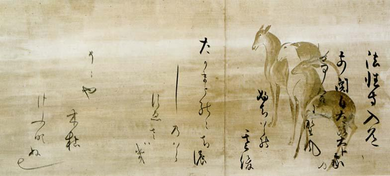
Japan's medieval period (the Kamakura, Nanbokuchō and Muromachi periods, and sometimes the Azuchi–Momoyama period) was a transitional period for the nation's literature. Kyoto ceased being the sole literary centre as important writers and readerships appeared throughout the country, and a wider variety of genres and literary forms developed accordingly, such as the gunki monogatari and otogi-zōshi prose narratives, and renga linked verse, as well as various theatrical forms such as noh. Medieval Japanese literature can be broadly divided into two periods: the early and late middle ages, the former lasting roughly 150 years from the late 12th to the mid-14th century, and the latter until the end of the 16th century.
The early middle ages saw a continuation of the literary trends of the classical period, with court fiction (monogatari) continuing to be written, and composition of waka poetry reaching new heights in the age of the Shin-kokin Wakashū, an anthology compiled by Fujiwara no Teika and others on the order of Emperor Go-Toba. One new genre of that emerged in this period was the gunki monogatari, or war tale, of which the representative example of The Tale of the Heike, a dramatic retelling of the events of the wars between the Minamoto and Taira clans. Apart from these heroic tales, several other historical and quasi-historical works were produced in this period, including Mizu Kagami and the Gukanshō. Essays called zuihitsu came to prominence with Hōjōki by Kamo no Chōmei and Tsurezuregusa by Kenkō. Japanese Buddhism also underwent a reform during this period, with several important new sects being established, with the founders of these sects—most famously Dōgen, Shinran, and Nichiren—writing numerous treatises expounding their interpretation of Buddhist doctrine. Writing in classical Chinese, with varying degrees of literary merit and varying degrees of direct influence from literature composed on the continent, continued to be a facet of Japanese literature as it had been since Japanese literature's beginnings [ja].
The late middle ages saw further shifts in literary trends. Gunki monogatari remained popular, with such famous works as the Taiheiki and the Soga Monogatari appearing, reflecting the chaotic civil war the country was experiencing at the time. The courtly fiction of early eras gave way to the otogi-zōshi, which were broader in theme and popular appeal but generally much shorter in length. Waka composition, which had already been in stagnation since the Shin-kokin Wakashū, continued to decline, but this gave way to new poetic forms such as renga and its variant haikai no renga (a forerunner to the later haiku). The performing arts flourished during the late medieval period, the noh theatre and its more informal cousin kyōgen being the best-known genres. Folk songs and religious and secular tales were collects in a number of anthologies, and travel literature, which had been growing in popularity throughout the medieval period, became more and more commonplace. During the late 16th century, Christian missionaries and their Japanese converts produced the first Japanese translations of European works. Isoho Monogatari, a translation of Aesop's Fables, remained in circulation even after the country largely closed itself off to the west during the Edo period.